Higher Nationals Unit 19: Resource and Talent Planning Report
VerifiedAdded on 2023/01/13
|23
|8572
|90
Report
AI Summary
This report delves into the critical aspects of resource and talent planning, focusing on a case study of Marks and Spencer. It begins with an analysis of the labor market, exploring current trends such as aging populations, technological advancements, and industry 4.0, and their impact on talent management and workforce planning. The report also examines relevant legislation, including the Health and Safety Act, and its influence on workforce strategies. Part 2 focuses on recruitment and selection, including the development of a process flowchart, job analysis, job descriptions, and person specifications, along with recommendations for improvement. Finally, the report evaluates the stages of the HR life cycle in specific contexts, relating each stage to organizational HR strategy. The report aims to provide a comprehensive overview of resource and talent planning, offering insights into labor market dynamics, recruitment strategies, and the management of the employee lifecycle.
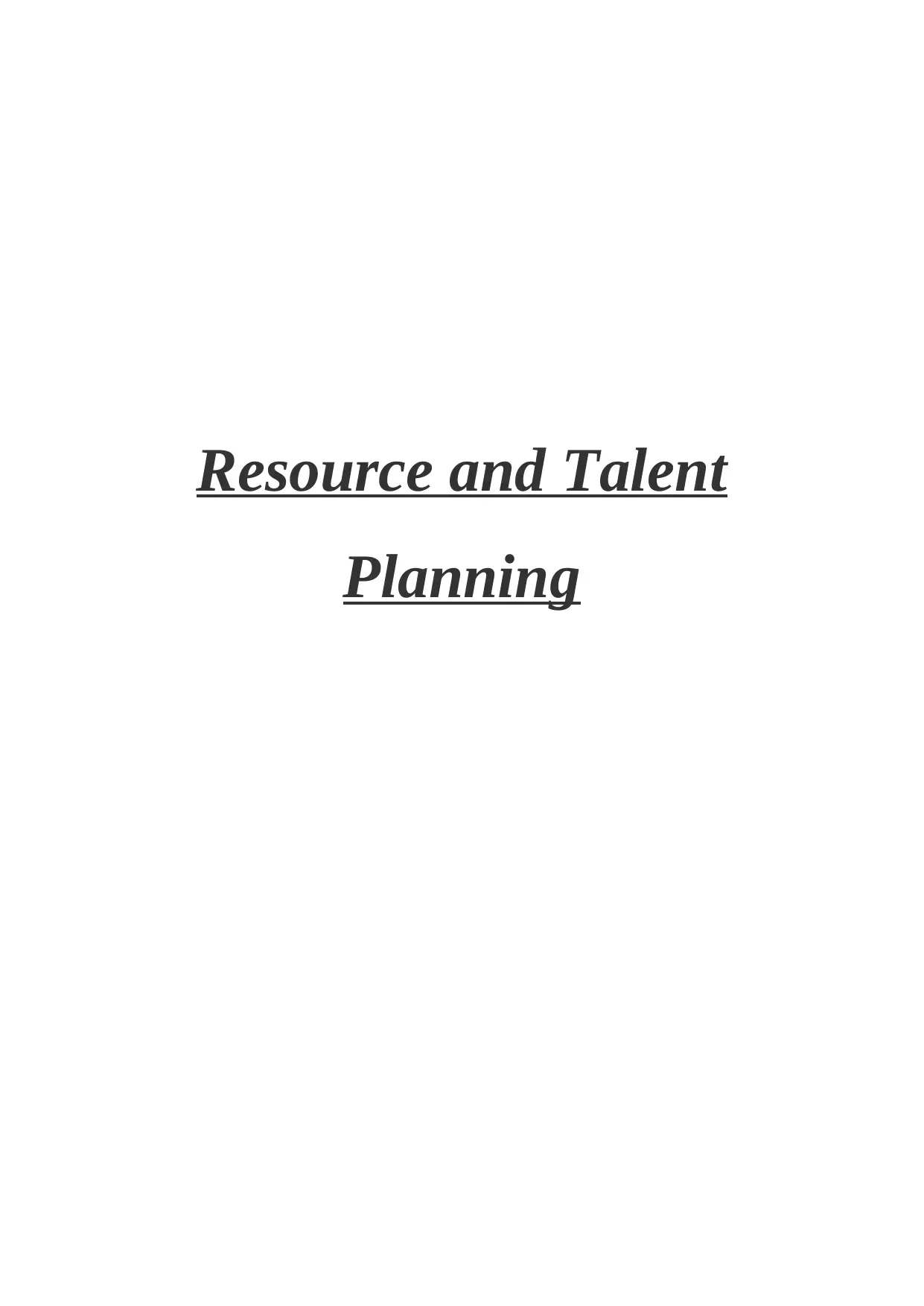
Resource and Talent
Planning
Planning
Paraphrase This Document
Need a fresh take? Get an instant paraphrase of this document with our AI Paraphraser
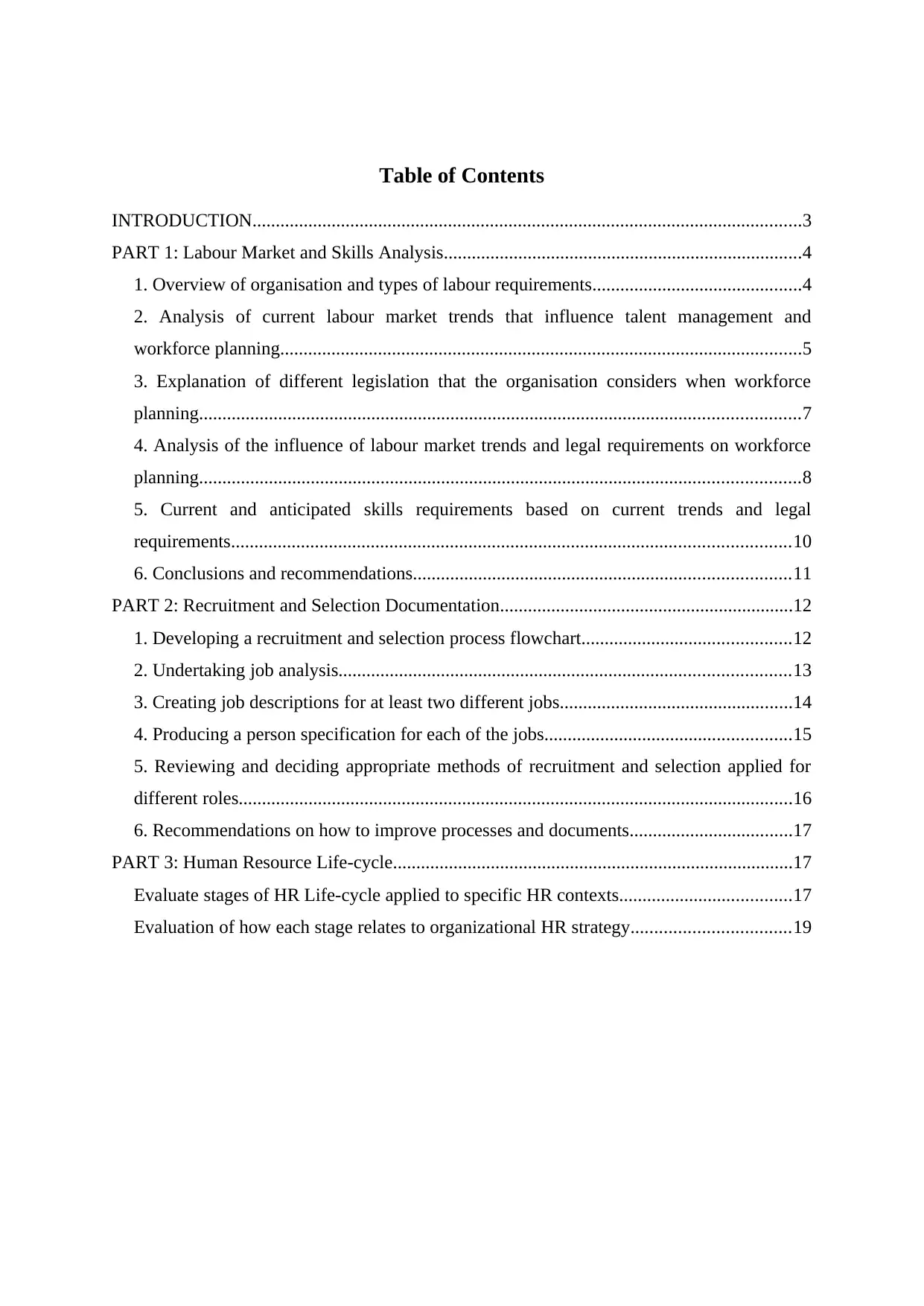
Table of Contents
INTRODUCTION......................................................................................................................3
PART 1: Labour Market and Skills Analysis.............................................................................4
1. Overview of organisation and types of labour requirements.............................................4
2. Analysis of current labour market trends that influence talent management and
workforce planning................................................................................................................5
3. Explanation of different legislation that the organisation considers when workforce
planning.................................................................................................................................7
4. Analysis of the influence of labour market trends and legal requirements on workforce
planning.................................................................................................................................8
5. Current and anticipated skills requirements based on current trends and legal
requirements........................................................................................................................10
6. Conclusions and recommendations.................................................................................11
PART 2: Recruitment and Selection Documentation...............................................................12
1. Developing a recruitment and selection process flowchart.............................................12
2. Undertaking job analysis.................................................................................................13
3. Creating job descriptions for at least two different jobs..................................................14
4. Producing a person specification for each of the jobs.....................................................15
5. Reviewing and deciding appropriate methods of recruitment and selection applied for
different roles.......................................................................................................................16
6. Recommendations on how to improve processes and documents...................................17
PART 3: Human Resource Life-cycle......................................................................................17
Evaluate stages of HR Life-cycle applied to specific HR contexts.....................................17
Evaluation of how each stage relates to organizational HR strategy..................................19
INTRODUCTION......................................................................................................................3
PART 1: Labour Market and Skills Analysis.............................................................................4
1. Overview of organisation and types of labour requirements.............................................4
2. Analysis of current labour market trends that influence talent management and
workforce planning................................................................................................................5
3. Explanation of different legislation that the organisation considers when workforce
planning.................................................................................................................................7
4. Analysis of the influence of labour market trends and legal requirements on workforce
planning.................................................................................................................................8
5. Current and anticipated skills requirements based on current trends and legal
requirements........................................................................................................................10
6. Conclusions and recommendations.................................................................................11
PART 2: Recruitment and Selection Documentation...............................................................12
1. Developing a recruitment and selection process flowchart.............................................12
2. Undertaking job analysis.................................................................................................13
3. Creating job descriptions for at least two different jobs..................................................14
4. Producing a person specification for each of the jobs.....................................................15
5. Reviewing and deciding appropriate methods of recruitment and selection applied for
different roles.......................................................................................................................16
6. Recommendations on how to improve processes and documents...................................17
PART 3: Human Resource Life-cycle......................................................................................17
Evaluate stages of HR Life-cycle applied to specific HR contexts.....................................17
Evaluation of how each stage relates to organizational HR strategy..................................19
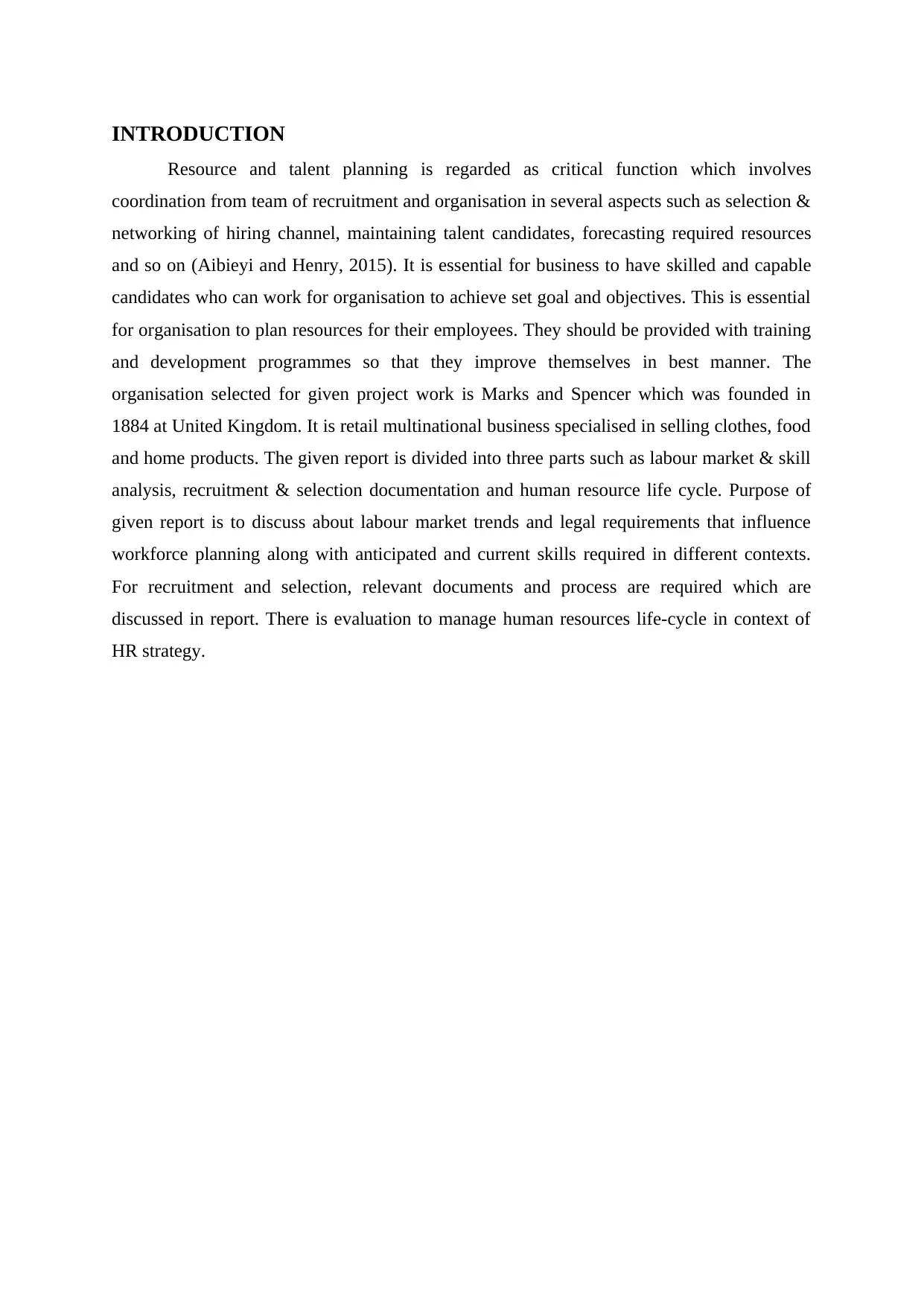
INTRODUCTION
Resource and talent planning is regarded as critical function which involves
coordination from team of recruitment and organisation in several aspects such as selection &
networking of hiring channel, maintaining talent candidates, forecasting required resources
and so on (Aibieyi and Henry, 2015). It is essential for business to have skilled and capable
candidates who can work for organisation to achieve set goal and objectives. This is essential
for organisation to plan resources for their employees. They should be provided with training
and development programmes so that they improve themselves in best manner. The
organisation selected for given project work is Marks and Spencer which was founded in
1884 at United Kingdom. It is retail multinational business specialised in selling clothes, food
and home products. The given report is divided into three parts such as labour market & skill
analysis, recruitment & selection documentation and human resource life cycle. Purpose of
given report is to discuss about labour market trends and legal requirements that influence
workforce planning along with anticipated and current skills required in different contexts.
For recruitment and selection, relevant documents and process are required which are
discussed in report. There is evaluation to manage human resources life-cycle in context of
HR strategy.
Resource and talent planning is regarded as critical function which involves
coordination from team of recruitment and organisation in several aspects such as selection &
networking of hiring channel, maintaining talent candidates, forecasting required resources
and so on (Aibieyi and Henry, 2015). It is essential for business to have skilled and capable
candidates who can work for organisation to achieve set goal and objectives. This is essential
for organisation to plan resources for their employees. They should be provided with training
and development programmes so that they improve themselves in best manner. The
organisation selected for given project work is Marks and Spencer which was founded in
1884 at United Kingdom. It is retail multinational business specialised in selling clothes, food
and home products. The given report is divided into three parts such as labour market & skill
analysis, recruitment & selection documentation and human resource life cycle. Purpose of
given report is to discuss about labour market trends and legal requirements that influence
workforce planning along with anticipated and current skills required in different contexts.
For recruitment and selection, relevant documents and process are required which are
discussed in report. There is evaluation to manage human resources life-cycle in context of
HR strategy.
⊘ This is a preview!⊘
Do you want full access?
Subscribe today to unlock all pages.

Trusted by 1+ million students worldwide
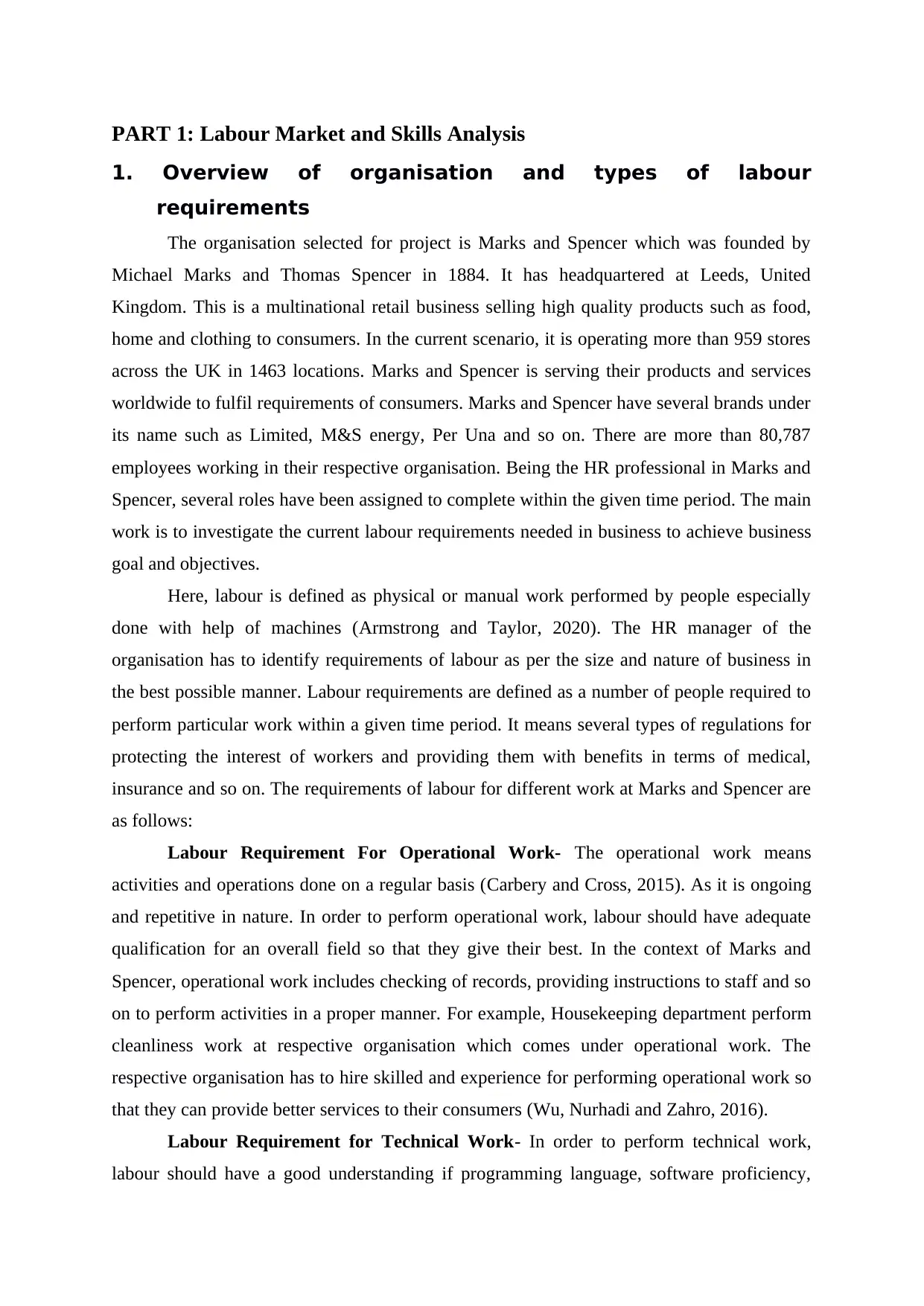
PART 1: Labour Market and Skills Analysis
1. Overview of organisation and types of labour
requirements
The organisation selected for project is Marks and Spencer which was founded by
Michael Marks and Thomas Spencer in 1884. It has headquartered at Leeds, United
Kingdom. This is a multinational retail business selling high quality products such as food,
home and clothing to consumers. In the current scenario, it is operating more than 959 stores
across the UK in 1463 locations. Marks and Spencer is serving their products and services
worldwide to fulfil requirements of consumers. Marks and Spencer have several brands under
its name such as Limited, M&S energy, Per Una and so on. There are more than 80,787
employees working in their respective organisation. Being the HR professional in Marks and
Spencer, several roles have been assigned to complete within the given time period. The main
work is to investigate the current labour requirements needed in business to achieve business
goal and objectives.
Here, labour is defined as physical or manual work performed by people especially
done with help of machines (Armstrong and Taylor, 2020). The HR manager of the
organisation has to identify requirements of labour as per the size and nature of business in
the best possible manner. Labour requirements are defined as a number of people required to
perform particular work within a given time period. It means several types of regulations for
protecting the interest of workers and providing them with benefits in terms of medical,
insurance and so on. The requirements of labour for different work at Marks and Spencer are
as follows:
Labour Requirement For Operational Work- The operational work means
activities and operations done on a regular basis (Carbery and Cross, 2015). As it is ongoing
and repetitive in nature. In order to perform operational work, labour should have adequate
qualification for an overall field so that they give their best. In the context of Marks and
Spencer, operational work includes checking of records, providing instructions to staff and so
on to perform activities in a proper manner. For example, Housekeeping department perform
cleanliness work at respective organisation which comes under operational work. The
respective organisation has to hire skilled and experience for performing operational work so
that they can provide better services to their consumers (Wu, Nurhadi and Zahro, 2016).
Labour Requirement for Technical Work- In order to perform technical work,
labour should have a good understanding if programming language, software proficiency,
1. Overview of organisation and types of labour
requirements
The organisation selected for project is Marks and Spencer which was founded by
Michael Marks and Thomas Spencer in 1884. It has headquartered at Leeds, United
Kingdom. This is a multinational retail business selling high quality products such as food,
home and clothing to consumers. In the current scenario, it is operating more than 959 stores
across the UK in 1463 locations. Marks and Spencer is serving their products and services
worldwide to fulfil requirements of consumers. Marks and Spencer have several brands under
its name such as Limited, M&S energy, Per Una and so on. There are more than 80,787
employees working in their respective organisation. Being the HR professional in Marks and
Spencer, several roles have been assigned to complete within the given time period. The main
work is to investigate the current labour requirements needed in business to achieve business
goal and objectives.
Here, labour is defined as physical or manual work performed by people especially
done with help of machines (Armstrong and Taylor, 2020). The HR manager of the
organisation has to identify requirements of labour as per the size and nature of business in
the best possible manner. Labour requirements are defined as a number of people required to
perform particular work within a given time period. It means several types of regulations for
protecting the interest of workers and providing them with benefits in terms of medical,
insurance and so on. The requirements of labour for different work at Marks and Spencer are
as follows:
Labour Requirement For Operational Work- The operational work means
activities and operations done on a regular basis (Carbery and Cross, 2015). As it is ongoing
and repetitive in nature. In order to perform operational work, labour should have adequate
qualification for an overall field so that they give their best. In the context of Marks and
Spencer, operational work includes checking of records, providing instructions to staff and so
on to perform activities in a proper manner. For example, Housekeeping department perform
cleanliness work at respective organisation which comes under operational work. The
respective organisation has to hire skilled and experience for performing operational work so
that they can provide better services to their consumers (Wu, Nurhadi and Zahro, 2016).
Labour Requirement for Technical Work- In order to perform technical work,
labour should have a good understanding if programming language, software proficiency,
Paraphrase This Document
Need a fresh take? Get an instant paraphrase of this document with our AI Paraphraser
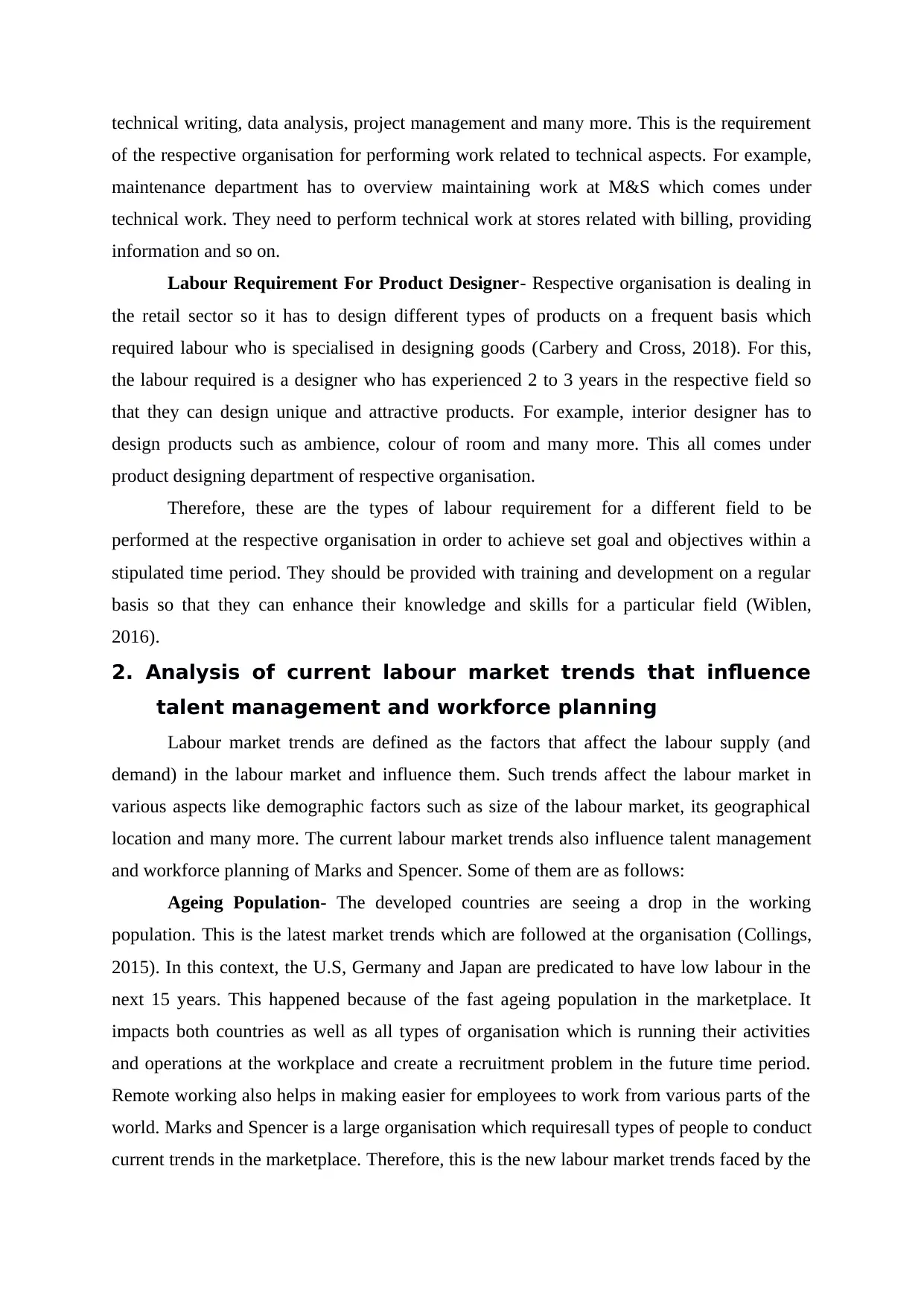
technical writing, data analysis, project management and many more. This is the requirement
of the respective organisation for performing work related to technical aspects. For example,
maintenance department has to overview maintaining work at M&S which comes under
technical work. They need to perform technical work at stores related with billing, providing
information and so on.
Labour Requirement For Product Designer- Respective organisation is dealing in
the retail sector so it has to design different types of products on a frequent basis which
required labour who is specialised in designing goods (Carbery and Cross, 2018). For this,
the labour required is a designer who has experienced 2 to 3 years in the respective field so
that they can design unique and attractive products. For example, interior designer has to
design products such as ambience, colour of room and many more. This all comes under
product designing department of respective organisation.
Therefore, these are the types of labour requirement for a different field to be
performed at the respective organisation in order to achieve set goal and objectives within a
stipulated time period. They should be provided with training and development on a regular
basis so that they can enhance their knowledge and skills for a particular field (Wiblen,
2016).
2. Analysis of current labour market trends that influence
talent management and workforce planning
Labour market trends are defined as the factors that affect the labour supply (and
demand) in the labour market and influence them. Such trends affect the labour market in
various aspects like demographic factors such as size of the labour market, its geographical
location and many more. The current labour market trends also influence talent management
and workforce planning of Marks and Spencer. Some of them are as follows:
Ageing Population- The developed countries are seeing a drop in the working
population. This is the latest market trends which are followed at the organisation (Collings,
2015). In this context, the U.S, Germany and Japan are predicated to have low labour in the
next 15 years. This happened because of the fast ageing population in the marketplace. It
impacts both countries as well as all types of organisation which is running their activities
and operations at the workplace and create a recruitment problem in the future time period.
Remote working also helps in making easier for employees to work from various parts of the
world. Marks and Spencer is a large organisation which requiresall types of people to conduct
current trends in the marketplace. Therefore, this is the new labour market trends faced by the
of the respective organisation for performing work related to technical aspects. For example,
maintenance department has to overview maintaining work at M&S which comes under
technical work. They need to perform technical work at stores related with billing, providing
information and so on.
Labour Requirement For Product Designer- Respective organisation is dealing in
the retail sector so it has to design different types of products on a frequent basis which
required labour who is specialised in designing goods (Carbery and Cross, 2018). For this,
the labour required is a designer who has experienced 2 to 3 years in the respective field so
that they can design unique and attractive products. For example, interior designer has to
design products such as ambience, colour of room and many more. This all comes under
product designing department of respective organisation.
Therefore, these are the types of labour requirement for a different field to be
performed at the respective organisation in order to achieve set goal and objectives within a
stipulated time period. They should be provided with training and development on a regular
basis so that they can enhance their knowledge and skills for a particular field (Wiblen,
2016).
2. Analysis of current labour market trends that influence
talent management and workforce planning
Labour market trends are defined as the factors that affect the labour supply (and
demand) in the labour market and influence them. Such trends affect the labour market in
various aspects like demographic factors such as size of the labour market, its geographical
location and many more. The current labour market trends also influence talent management
and workforce planning of Marks and Spencer. Some of them are as follows:
Ageing Population- The developed countries are seeing a drop in the working
population. This is the latest market trends which are followed at the organisation (Collings,
2015). In this context, the U.S, Germany and Japan are predicated to have low labour in the
next 15 years. This happened because of the fast ageing population in the marketplace. It
impacts both countries as well as all types of organisation which is running their activities
and operations at the workplace and create a recruitment problem in the future time period.
Remote working also helps in making easier for employees to work from various parts of the
world. Marks and Spencer is a large organisation which requiresall types of people to conduct
current trends in the marketplace. Therefore, this is the new labour market trends faced by the
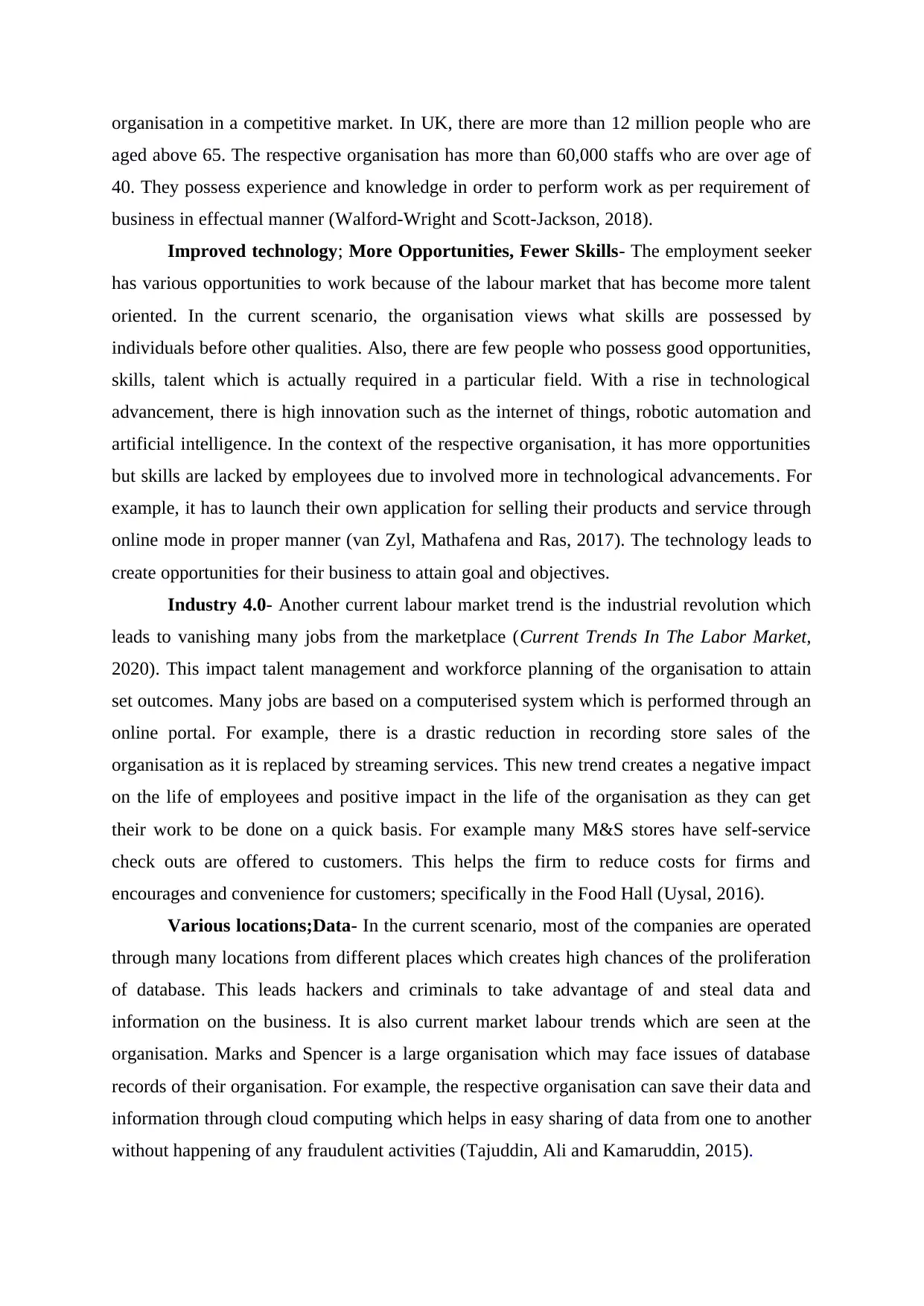
organisation in a competitive market. In UK, there are more than 12 million people who are
aged above 65. The respective organisation has more than 60,000 staffs who are over age of
40. They possess experience and knowledge in order to perform work as per requirement of
business in effectual manner (Walford-Wright and Scott-Jackson, 2018).
Improved technology; More Opportunities, Fewer Skills- The employment seeker
has various opportunities to work because of the labour market that has become more talent
oriented. In the current scenario, the organisation views what skills are possessed by
individuals before other qualities. Also, there are few people who possess good opportunities,
skills, talent which is actually required in a particular field. With a rise in technological
advancement, there is high innovation such as the internet of things, robotic automation and
artificial intelligence. In the context of the respective organisation, it has more opportunities
but skills are lacked by employees due to involved more in technological advancements. For
example, it has to launch their own application for selling their products and service through
online mode in proper manner (van Zyl, Mathafena and Ras, 2017). The technology leads to
create opportunities for their business to attain goal and objectives.
Industry 4.0- Another current labour market trend is the industrial revolution which
leads to vanishing many jobs from the marketplace (Current Trends In The Labor Market,
2020). This impact talent management and workforce planning of the organisation to attain
set outcomes. Many jobs are based on a computerised system which is performed through an
online portal. For example, there is a drastic reduction in recording store sales of the
organisation as it is replaced by streaming services. This new trend creates a negative impact
on the life of employees and positive impact in the life of the organisation as they can get
their work to be done on a quick basis. For example many M&S stores have self-service
check outs are offered to customers. This helps the firm to reduce costs for firms and
encourages and convenience for customers; specifically in the Food Hall (Uysal, 2016).
Various locations;Data- In the current scenario, most of the companies are operated
through many locations from different places which creates high chances of the proliferation
of database. This leads hackers and criminals to take advantage of and steal data and
information on the business. It is also current market labour trends which are seen at the
organisation. Marks and Spencer is a large organisation which may face issues of database
records of their organisation. For example, the respective organisation can save their data and
information through cloud computing which helps in easy sharing of data from one to another
without happening of any fraudulent activities (Tajuddin, Ali and Kamaruddin, 2015).
aged above 65. The respective organisation has more than 60,000 staffs who are over age of
40. They possess experience and knowledge in order to perform work as per requirement of
business in effectual manner (Walford-Wright and Scott-Jackson, 2018).
Improved technology; More Opportunities, Fewer Skills- The employment seeker
has various opportunities to work because of the labour market that has become more talent
oriented. In the current scenario, the organisation views what skills are possessed by
individuals before other qualities. Also, there are few people who possess good opportunities,
skills, talent which is actually required in a particular field. With a rise in technological
advancement, there is high innovation such as the internet of things, robotic automation and
artificial intelligence. In the context of the respective organisation, it has more opportunities
but skills are lacked by employees due to involved more in technological advancements. For
example, it has to launch their own application for selling their products and service through
online mode in proper manner (van Zyl, Mathafena and Ras, 2017). The technology leads to
create opportunities for their business to attain goal and objectives.
Industry 4.0- Another current labour market trend is the industrial revolution which
leads to vanishing many jobs from the marketplace (Current Trends In The Labor Market,
2020). This impact talent management and workforce planning of the organisation to attain
set outcomes. Many jobs are based on a computerised system which is performed through an
online portal. For example, there is a drastic reduction in recording store sales of the
organisation as it is replaced by streaming services. This new trend creates a negative impact
on the life of employees and positive impact in the life of the organisation as they can get
their work to be done on a quick basis. For example many M&S stores have self-service
check outs are offered to customers. This helps the firm to reduce costs for firms and
encourages and convenience for customers; specifically in the Food Hall (Uysal, 2016).
Various locations;Data- In the current scenario, most of the companies are operated
through many locations from different places which creates high chances of the proliferation
of database. This leads hackers and criminals to take advantage of and steal data and
information on the business. It is also current market labour trends which are seen at the
organisation. Marks and Spencer is a large organisation which may face issues of database
records of their organisation. For example, the respective organisation can save their data and
information through cloud computing which helps in easy sharing of data from one to another
without happening of any fraudulent activities (Tajuddin, Ali and Kamaruddin, 2015).
⊘ This is a preview!⊘
Do you want full access?
Subscribe today to unlock all pages.

Trusted by 1+ million students worldwide
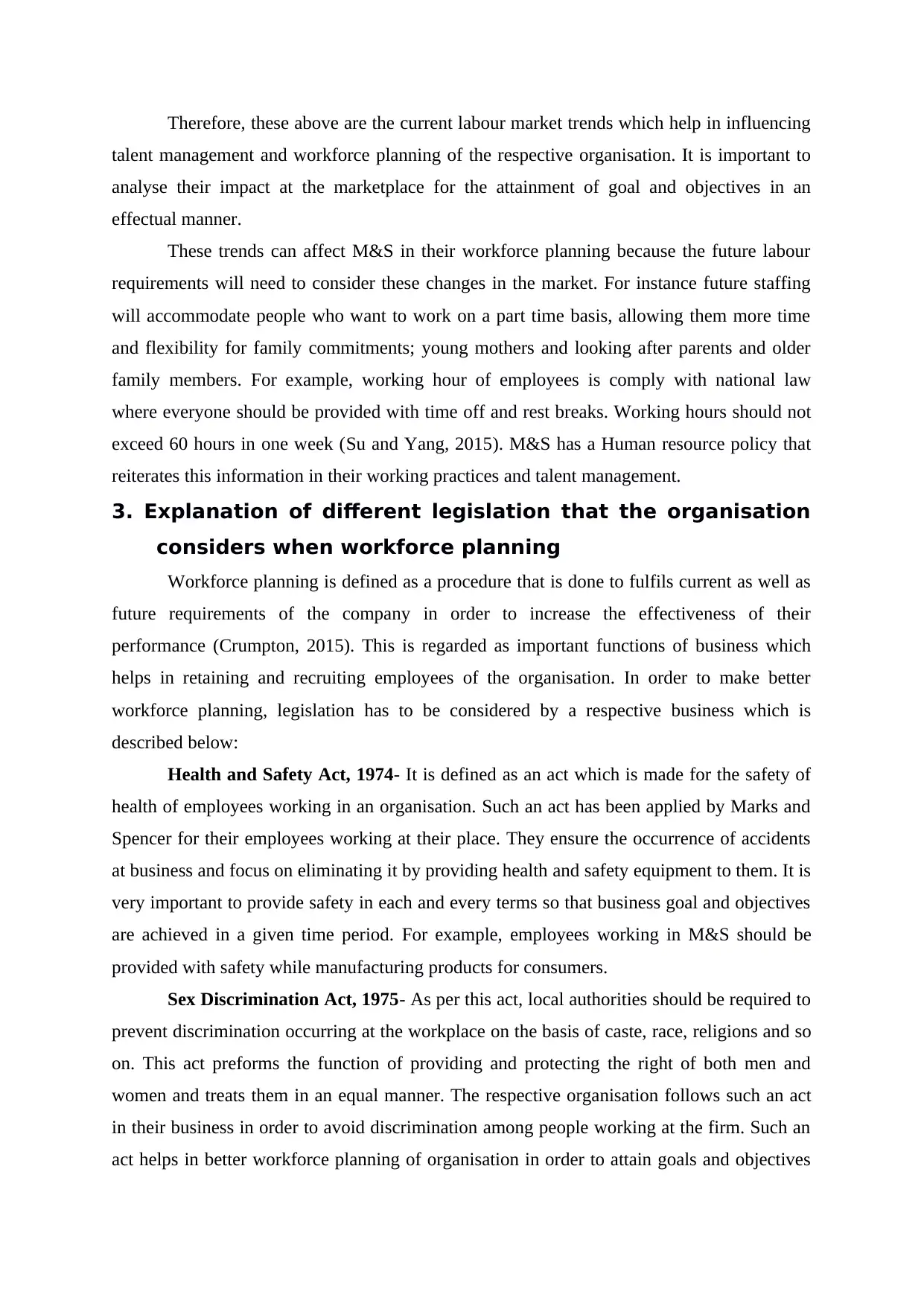
Therefore, these above are the current labour market trends which help in influencing
talent management and workforce planning of the respective organisation. It is important to
analyse their impact at the marketplace for the attainment of goal and objectives in an
effectual manner.
These trends can affect M&S in their workforce planning because the future labour
requirements will need to consider these changes in the market. For instance future staffing
will accommodate people who want to work on a part time basis, allowing them more time
and flexibility for family commitments; young mothers and looking after parents and older
family members. For example, working hour of employees is comply with national law
where everyone should be provided with time off and rest breaks. Working hours should not
exceed 60 hours in one week (Su and Yang, 2015). M&S has a Human resource policy that
reiterates this information in their working practices and talent management.
3. Explanation of different legislation that the organisation
considers when workforce planning
Workforce planning is defined as a procedure that is done to fulfils current as well as
future requirements of the company in order to increase the effectiveness of their
performance (Crumpton, 2015). This is regarded as important functions of business which
helps in retaining and recruiting employees of the organisation. In order to make better
workforce planning, legislation has to be considered by a respective business which is
described below:
Health and Safety Act, 1974- It is defined as an act which is made for the safety of
health of employees working in an organisation. Such an act has been applied by Marks and
Spencer for their employees working at their place. They ensure the occurrence of accidents
at business and focus on eliminating it by providing health and safety equipment to them. It is
very important to provide safety in each and every terms so that business goal and objectives
are achieved in a given time period. For example, employees working in M&S should be
provided with safety while manufacturing products for consumers.
Sex Discrimination Act, 1975- As per this act, local authorities should be required to
prevent discrimination occurring at the workplace on the basis of caste, race, religions and so
on. This act preforms the function of providing and protecting the right of both men and
women and treats them in an equal manner. The respective organisation follows such an act
in their business in order to avoid discrimination among people working at the firm. Such an
act helps in better workforce planning of organisation in order to attain goals and objectives
talent management and workforce planning of the respective organisation. It is important to
analyse their impact at the marketplace for the attainment of goal and objectives in an
effectual manner.
These trends can affect M&S in their workforce planning because the future labour
requirements will need to consider these changes in the market. For instance future staffing
will accommodate people who want to work on a part time basis, allowing them more time
and flexibility for family commitments; young mothers and looking after parents and older
family members. For example, working hour of employees is comply with national law
where everyone should be provided with time off and rest breaks. Working hours should not
exceed 60 hours in one week (Su and Yang, 2015). M&S has a Human resource policy that
reiterates this information in their working practices and talent management.
3. Explanation of different legislation that the organisation
considers when workforce planning
Workforce planning is defined as a procedure that is done to fulfils current as well as
future requirements of the company in order to increase the effectiveness of their
performance (Crumpton, 2015). This is regarded as important functions of business which
helps in retaining and recruiting employees of the organisation. In order to make better
workforce planning, legislation has to be considered by a respective business which is
described below:
Health and Safety Act, 1974- It is defined as an act which is made for the safety of
health of employees working in an organisation. Such an act has been applied by Marks and
Spencer for their employees working at their place. They ensure the occurrence of accidents
at business and focus on eliminating it by providing health and safety equipment to them. It is
very important to provide safety in each and every terms so that business goal and objectives
are achieved in a given time period. For example, employees working in M&S should be
provided with safety while manufacturing products for consumers.
Sex Discrimination Act, 1975- As per this act, local authorities should be required to
prevent discrimination occurring at the workplace on the basis of caste, race, religions and so
on. This act preforms the function of providing and protecting the right of both men and
women and treats them in an equal manner. The respective organisation follows such an act
in their business in order to avoid discrimination among people working at the firm. Such an
act helps in better workforce planning of organisation in order to attain goals and objectives
Paraphrase This Document
Need a fresh take? Get an instant paraphrase of this document with our AI Paraphraser
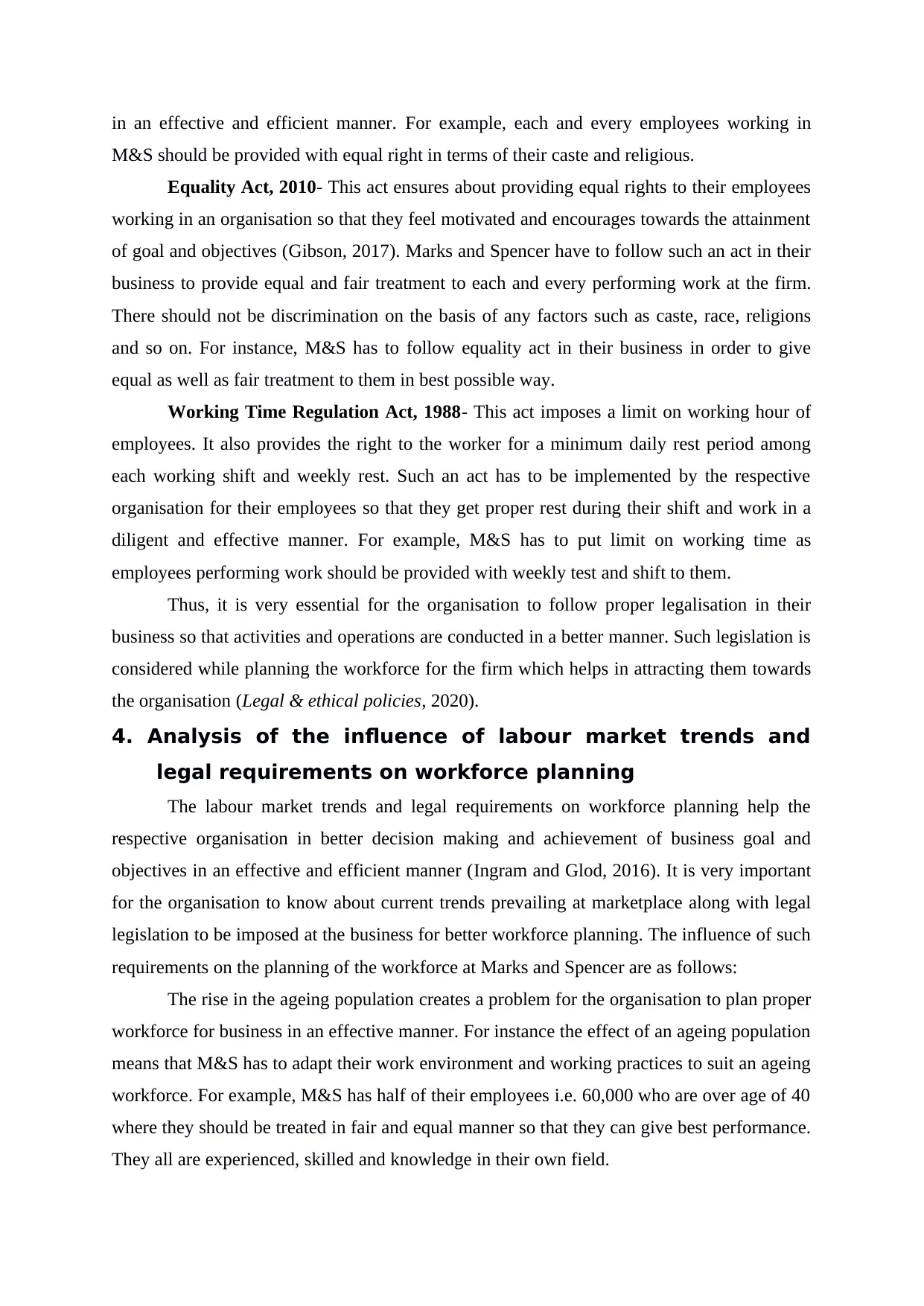
in an effective and efficient manner. For example, each and every employees working in
M&S should be provided with equal right in terms of their caste and religious.
Equality Act, 2010- This act ensures about providing equal rights to their employees
working in an organisation so that they feel motivated and encourages towards the attainment
of goal and objectives (Gibson, 2017). Marks and Spencer have to follow such an act in their
business to provide equal and fair treatment to each and every performing work at the firm.
There should not be discrimination on the basis of any factors such as caste, race, religions
and so on. For instance, M&S has to follow equality act in their business in order to give
equal as well as fair treatment to them in best possible way.
Working Time Regulation Act, 1988- This act imposes a limit on working hour of
employees. It also provides the right to the worker for a minimum daily rest period among
each working shift and weekly rest. Such an act has to be implemented by the respective
organisation for their employees so that they get proper rest during their shift and work in a
diligent and effective manner. For example, M&S has to put limit on working time as
employees performing work should be provided with weekly test and shift to them.
Thus, it is very essential for the organisation to follow proper legalisation in their
business so that activities and operations are conducted in a better manner. Such legislation is
considered while planning the workforce for the firm which helps in attracting them towards
the organisation (Legal & ethical policies, 2020).
4. Analysis of the influence of labour market trends and
legal requirements on workforce planning
The labour market trends and legal requirements on workforce planning help the
respective organisation in better decision making and achievement of business goal and
objectives in an effective and efficient manner (Ingram and Glod, 2016). It is very important
for the organisation to know about current trends prevailing at marketplace along with legal
legislation to be imposed at the business for better workforce planning. The influence of such
requirements on the planning of the workforce at Marks and Spencer are as follows:
The rise in the ageing population creates a problem for the organisation to plan proper
workforce for business in an effective manner. For instance the effect of an ageing population
means that M&S has to adapt their work environment and working practices to suit an ageing
workforce. For example, M&S has half of their employees i.e. 60,000 who are over age of 40
where they should be treated in fair and equal manner so that they can give best performance.
They all are experienced, skilled and knowledge in their own field.
M&S should be provided with equal right in terms of their caste and religious.
Equality Act, 2010- This act ensures about providing equal rights to their employees
working in an organisation so that they feel motivated and encourages towards the attainment
of goal and objectives (Gibson, 2017). Marks and Spencer have to follow such an act in their
business to provide equal and fair treatment to each and every performing work at the firm.
There should not be discrimination on the basis of any factors such as caste, race, religions
and so on. For instance, M&S has to follow equality act in their business in order to give
equal as well as fair treatment to them in best possible way.
Working Time Regulation Act, 1988- This act imposes a limit on working hour of
employees. It also provides the right to the worker for a minimum daily rest period among
each working shift and weekly rest. Such an act has to be implemented by the respective
organisation for their employees so that they get proper rest during their shift and work in a
diligent and effective manner. For example, M&S has to put limit on working time as
employees performing work should be provided with weekly test and shift to them.
Thus, it is very essential for the organisation to follow proper legalisation in their
business so that activities and operations are conducted in a better manner. Such legislation is
considered while planning the workforce for the firm which helps in attracting them towards
the organisation (Legal & ethical policies, 2020).
4. Analysis of the influence of labour market trends and
legal requirements on workforce planning
The labour market trends and legal requirements on workforce planning help the
respective organisation in better decision making and achievement of business goal and
objectives in an effective and efficient manner (Ingram and Glod, 2016). It is very important
for the organisation to know about current trends prevailing at marketplace along with legal
legislation to be imposed at the business for better workforce planning. The influence of such
requirements on the planning of the workforce at Marks and Spencer are as follows:
The rise in the ageing population creates a problem for the organisation to plan proper
workforce for business in an effective manner. For instance the effect of an ageing population
means that M&S has to adapt their work environment and working practices to suit an ageing
workforce. For example, M&S has half of their employees i.e. 60,000 who are over age of 40
where they should be treated in fair and equal manner so that they can give best performance.
They all are experienced, skilled and knowledge in their own field.
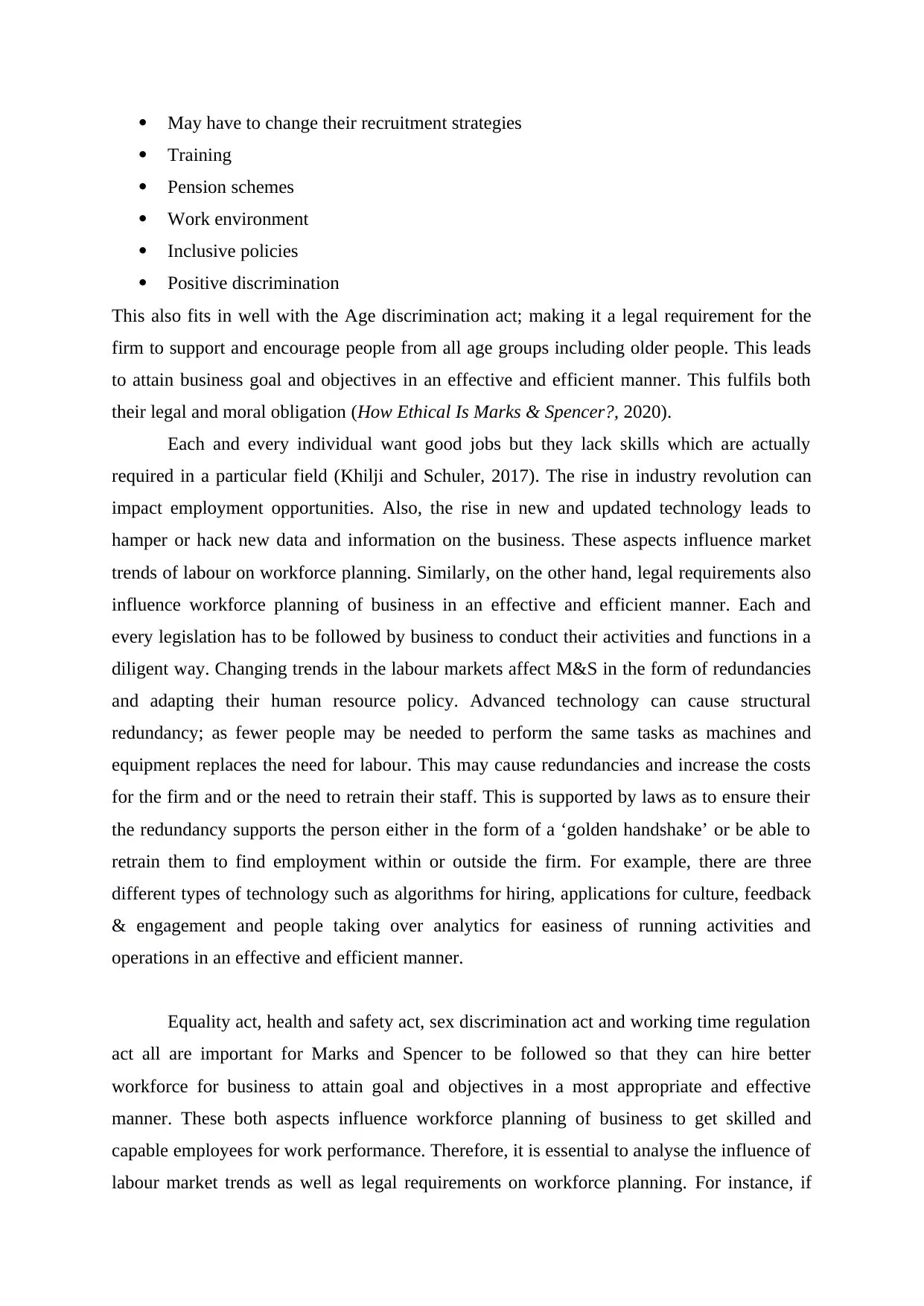
May have to change their recruitment strategies
Training
Pension schemes
Work environment
Inclusive policies
Positive discrimination
This also fits in well with the Age discrimination act; making it a legal requirement for the
firm to support and encourage people from all age groups including older people. This leads
to attain business goal and objectives in an effective and efficient manner. This fulfils both
their legal and moral obligation (How Ethical Is Marks & Spencer?, 2020).
Each and every individual want good jobs but they lack skills which are actually
required in a particular field (Khilji and Schuler, 2017). The rise in industry revolution can
impact employment opportunities. Also, the rise in new and updated technology leads to
hamper or hack new data and information on the business. These aspects influence market
trends of labour on workforce planning. Similarly, on the other hand, legal requirements also
influence workforce planning of business in an effective and efficient manner. Each and
every legislation has to be followed by business to conduct their activities and functions in a
diligent way. Changing trends in the labour markets affect M&S in the form of redundancies
and adapting their human resource policy. Advanced technology can cause structural
redundancy; as fewer people may be needed to perform the same tasks as machines and
equipment replaces the need for labour. This may cause redundancies and increase the costs
for the firm and or the need to retrain their staff. This is supported by laws as to ensure their
the redundancy supports the person either in the form of a ‘golden handshake’ or be able to
retrain them to find employment within or outside the firm. For example, there are three
different types of technology such as algorithms for hiring, applications for culture, feedback
& engagement and people taking over analytics for easiness of running activities and
operations in an effective and efficient manner.
Equality act, health and safety act, sex discrimination act and working time regulation
act all are important for Marks and Spencer to be followed so that they can hire better
workforce for business to attain goal and objectives in a most appropriate and effective
manner. These both aspects influence workforce planning of business to get skilled and
capable employees for work performance. Therefore, it is essential to analyse the influence of
labour market trends as well as legal requirements on workforce planning. For instance, if
Training
Pension schemes
Work environment
Inclusive policies
Positive discrimination
This also fits in well with the Age discrimination act; making it a legal requirement for the
firm to support and encourage people from all age groups including older people. This leads
to attain business goal and objectives in an effective and efficient manner. This fulfils both
their legal and moral obligation (How Ethical Is Marks & Spencer?, 2020).
Each and every individual want good jobs but they lack skills which are actually
required in a particular field (Khilji and Schuler, 2017). The rise in industry revolution can
impact employment opportunities. Also, the rise in new and updated technology leads to
hamper or hack new data and information on the business. These aspects influence market
trends of labour on workforce planning. Similarly, on the other hand, legal requirements also
influence workforce planning of business in an effective and efficient manner. Each and
every legislation has to be followed by business to conduct their activities and functions in a
diligent way. Changing trends in the labour markets affect M&S in the form of redundancies
and adapting their human resource policy. Advanced technology can cause structural
redundancy; as fewer people may be needed to perform the same tasks as machines and
equipment replaces the need for labour. This may cause redundancies and increase the costs
for the firm and or the need to retrain their staff. This is supported by laws as to ensure their
the redundancy supports the person either in the form of a ‘golden handshake’ or be able to
retrain them to find employment within or outside the firm. For example, there are three
different types of technology such as algorithms for hiring, applications for culture, feedback
& engagement and people taking over analytics for easiness of running activities and
operations in an effective and efficient manner.
Equality act, health and safety act, sex discrimination act and working time regulation
act all are important for Marks and Spencer to be followed so that they can hire better
workforce for business to attain goal and objectives in a most appropriate and effective
manner. These both aspects influence workforce planning of business to get skilled and
capable employees for work performance. Therefore, it is essential to analyse the influence of
labour market trends as well as legal requirements on workforce planning. For instance, if
⊘ This is a preview!⊘
Do you want full access?
Subscribe today to unlock all pages.

Trusted by 1+ million students worldwide
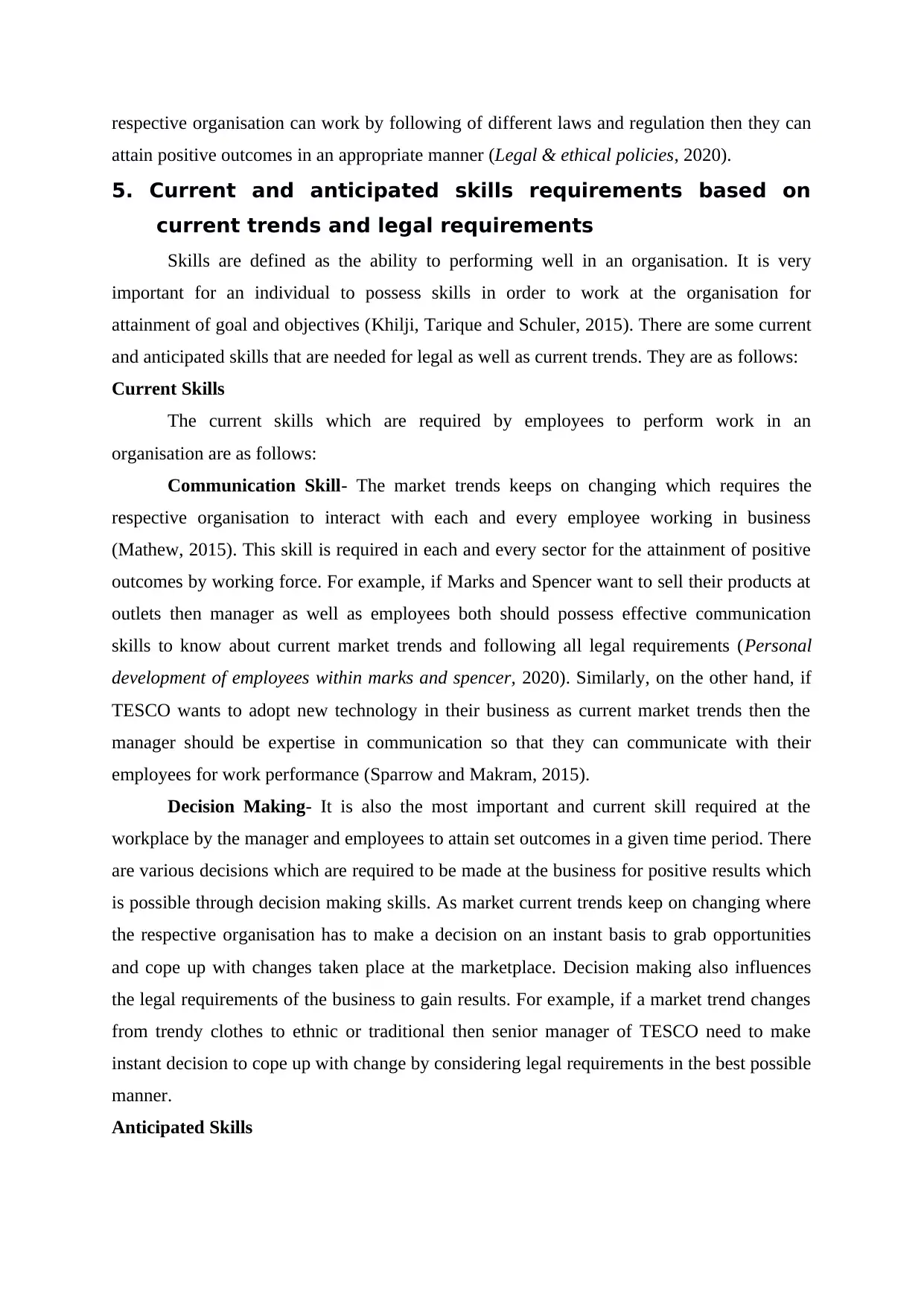
respective organisation can work by following of different laws and regulation then they can
attain positive outcomes in an appropriate manner (Legal & ethical policies, 2020).
5. Current and anticipated skills requirements based on
current trends and legal requirements
Skills are defined as the ability to performing well in an organisation. It is very
important for an individual to possess skills in order to work at the organisation for
attainment of goal and objectives (Khilji, Tarique and Schuler, 2015). There are some current
and anticipated skills that are needed for legal as well as current trends. They are as follows:
Current Skills
The current skills which are required by employees to perform work in an
organisation are as follows:
Communication Skill- The market trends keeps on changing which requires the
respective organisation to interact with each and every employee working in business
(Mathew, 2015). This skill is required in each and every sector for the attainment of positive
outcomes by working force. For example, if Marks and Spencer want to sell their products at
outlets then manager as well as employees both should possess effective communication
skills to know about current market trends and following all legal requirements (Personal
development of employees within marks and spencer, 2020). Similarly, on the other hand, if
TESCO wants to adopt new technology in their business as current market trends then the
manager should be expertise in communication so that they can communicate with their
employees for work performance (Sparrow and Makram, 2015).
Decision Making- It is also the most important and current skill required at the
workplace by the manager and employees to attain set outcomes in a given time period. There
are various decisions which are required to be made at the business for positive results which
is possible through decision making skills. As market current trends keep on changing where
the respective organisation has to make a decision on an instant basis to grab opportunities
and cope up with changes taken place at the marketplace. Decision making also influences
the legal requirements of the business to gain results. For example, if a market trend changes
from trendy clothes to ethnic or traditional then senior manager of TESCO need to make
instant decision to cope up with change by considering legal requirements in the best possible
manner.
Anticipated Skills
attain positive outcomes in an appropriate manner (Legal & ethical policies, 2020).
5. Current and anticipated skills requirements based on
current trends and legal requirements
Skills are defined as the ability to performing well in an organisation. It is very
important for an individual to possess skills in order to work at the organisation for
attainment of goal and objectives (Khilji, Tarique and Schuler, 2015). There are some current
and anticipated skills that are needed for legal as well as current trends. They are as follows:
Current Skills
The current skills which are required by employees to perform work in an
organisation are as follows:
Communication Skill- The market trends keeps on changing which requires the
respective organisation to interact with each and every employee working in business
(Mathew, 2015). This skill is required in each and every sector for the attainment of positive
outcomes by working force. For example, if Marks and Spencer want to sell their products at
outlets then manager as well as employees both should possess effective communication
skills to know about current market trends and following all legal requirements (Personal
development of employees within marks and spencer, 2020). Similarly, on the other hand, if
TESCO wants to adopt new technology in their business as current market trends then the
manager should be expertise in communication so that they can communicate with their
employees for work performance (Sparrow and Makram, 2015).
Decision Making- It is also the most important and current skill required at the
workplace by the manager and employees to attain set outcomes in a given time period. There
are various decisions which are required to be made at the business for positive results which
is possible through decision making skills. As market current trends keep on changing where
the respective organisation has to make a decision on an instant basis to grab opportunities
and cope up with changes taken place at the marketplace. Decision making also influences
the legal requirements of the business to gain results. For example, if a market trend changes
from trendy clothes to ethnic or traditional then senior manager of TESCO need to make
instant decision to cope up with change by considering legal requirements in the best possible
manner.
Anticipated Skills
Paraphrase This Document
Need a fresh take? Get an instant paraphrase of this document with our AI Paraphraser
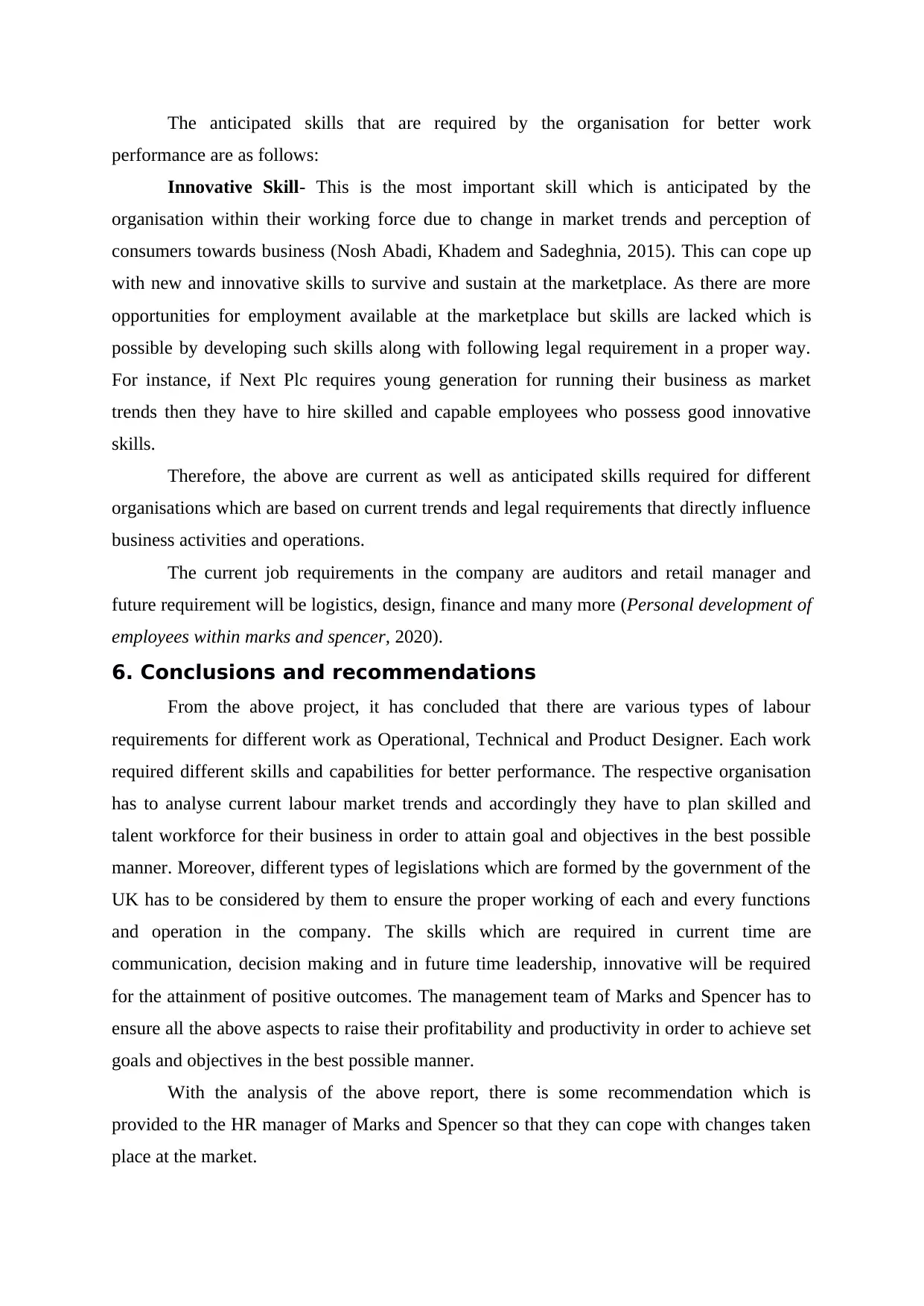
The anticipated skills that are required by the organisation for better work
performance are as follows:
Innovative Skill- This is the most important skill which is anticipated by the
organisation within their working force due to change in market trends and perception of
consumers towards business (Nosh Abadi, Khadem and Sadeghnia, 2015). This can cope up
with new and innovative skills to survive and sustain at the marketplace. As there are more
opportunities for employment available at the marketplace but skills are lacked which is
possible by developing such skills along with following legal requirement in a proper way.
For instance, if Next Plc requires young generation for running their business as market
trends then they have to hire skilled and capable employees who possess good innovative
skills.
Therefore, the above are current as well as anticipated skills required for different
organisations which are based on current trends and legal requirements that directly influence
business activities and operations.
The current job requirements in the company are auditors and retail manager and
future requirement will be logistics, design, finance and many more (Personal development of
employees within marks and spencer, 2020).
6. Conclusions and recommendations
From the above project, it has concluded that there are various types of labour
requirements for different work as Operational, Technical and Product Designer. Each work
required different skills and capabilities for better performance. The respective organisation
has to analyse current labour market trends and accordingly they have to plan skilled and
talent workforce for their business in order to attain goal and objectives in the best possible
manner. Moreover, different types of legislations which are formed by the government of the
UK has to be considered by them to ensure the proper working of each and every functions
and operation in the company. The skills which are required in current time are
communication, decision making and in future time leadership, innovative will be required
for the attainment of positive outcomes. The management team of Marks and Spencer has to
ensure all the above aspects to raise their profitability and productivity in order to achieve set
goals and objectives in the best possible manner.
With the analysis of the above report, there is some recommendation which is
provided to the HR manager of Marks and Spencer so that they can cope with changes taken
place at the market.
performance are as follows:
Innovative Skill- This is the most important skill which is anticipated by the
organisation within their working force due to change in market trends and perception of
consumers towards business (Nosh Abadi, Khadem and Sadeghnia, 2015). This can cope up
with new and innovative skills to survive and sustain at the marketplace. As there are more
opportunities for employment available at the marketplace but skills are lacked which is
possible by developing such skills along with following legal requirement in a proper way.
For instance, if Next Plc requires young generation for running their business as market
trends then they have to hire skilled and capable employees who possess good innovative
skills.
Therefore, the above are current as well as anticipated skills required for different
organisations which are based on current trends and legal requirements that directly influence
business activities and operations.
The current job requirements in the company are auditors and retail manager and
future requirement will be logistics, design, finance and many more (Personal development of
employees within marks and spencer, 2020).
6. Conclusions and recommendations
From the above project, it has concluded that there are various types of labour
requirements for different work as Operational, Technical and Product Designer. Each work
required different skills and capabilities for better performance. The respective organisation
has to analyse current labour market trends and accordingly they have to plan skilled and
talent workforce for their business in order to attain goal and objectives in the best possible
manner. Moreover, different types of legislations which are formed by the government of the
UK has to be considered by them to ensure the proper working of each and every functions
and operation in the company. The skills which are required in current time are
communication, decision making and in future time leadership, innovative will be required
for the attainment of positive outcomes. The management team of Marks and Spencer has to
ensure all the above aspects to raise their profitability and productivity in order to achieve set
goals and objectives in the best possible manner.
With the analysis of the above report, there is some recommendation which is
provided to the HR manager of Marks and Spencer so that they can cope with changes taken
place at the market.
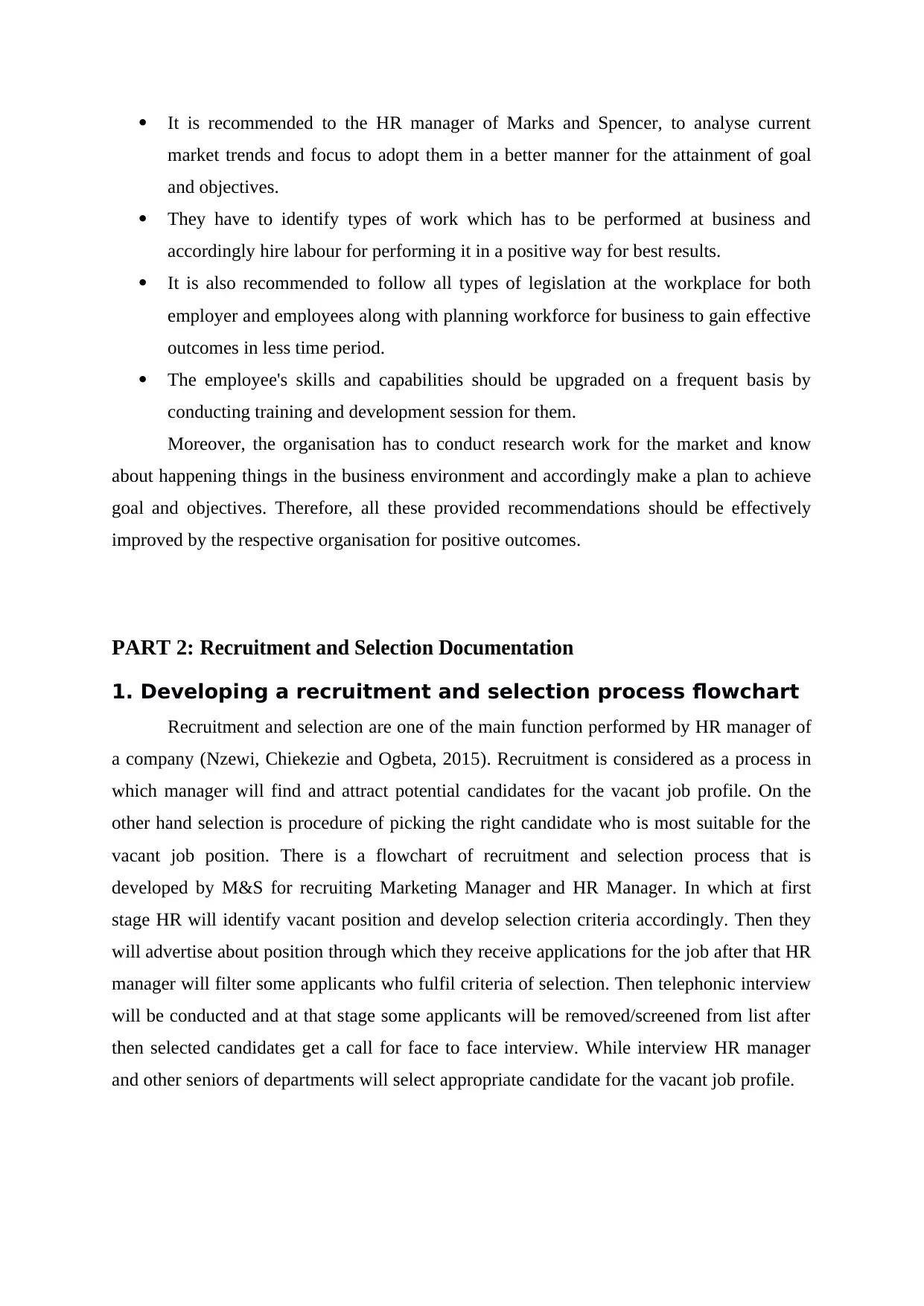
It is recommended to the HR manager of Marks and Spencer, to analyse current
market trends and focus to adopt them in a better manner for the attainment of goal
and objectives.
They have to identify types of work which has to be performed at business and
accordingly hire labour for performing it in a positive way for best results.
It is also recommended to follow all types of legislation at the workplace for both
employer and employees along with planning workforce for business to gain effective
outcomes in less time period.
The employee's skills and capabilities should be upgraded on a frequent basis by
conducting training and development session for them.
Moreover, the organisation has to conduct research work for the market and know
about happening things in the business environment and accordingly make a plan to achieve
goal and objectives. Therefore, all these provided recommendations should be effectively
improved by the respective organisation for positive outcomes.
PART 2: Recruitment and Selection Documentation
1. Developing a recruitment and selection process flowchart
Recruitment and selection are one of the main function performed by HR manager of
a company (Nzewi, Chiekezie and Ogbeta, 2015). Recruitment is considered as a process in
which manager will find and attract potential candidates for the vacant job profile. On the
other hand selection is procedure of picking the right candidate who is most suitable for the
vacant job position. There is a flowchart of recruitment and selection process that is
developed by M&S for recruiting Marketing Manager and HR Manager. In which at first
stage HR will identify vacant position and develop selection criteria accordingly. Then they
will advertise about position through which they receive applications for the job after that HR
manager will filter some applicants who fulfil criteria of selection. Then telephonic interview
will be conducted and at that stage some applicants will be removed/screened from list after
then selected candidates get a call for face to face interview. While interview HR manager
and other seniors of departments will select appropriate candidate for the vacant job profile.
market trends and focus to adopt them in a better manner for the attainment of goal
and objectives.
They have to identify types of work which has to be performed at business and
accordingly hire labour for performing it in a positive way for best results.
It is also recommended to follow all types of legislation at the workplace for both
employer and employees along with planning workforce for business to gain effective
outcomes in less time period.
The employee's skills and capabilities should be upgraded on a frequent basis by
conducting training and development session for them.
Moreover, the organisation has to conduct research work for the market and know
about happening things in the business environment and accordingly make a plan to achieve
goal and objectives. Therefore, all these provided recommendations should be effectively
improved by the respective organisation for positive outcomes.
PART 2: Recruitment and Selection Documentation
1. Developing a recruitment and selection process flowchart
Recruitment and selection are one of the main function performed by HR manager of
a company (Nzewi, Chiekezie and Ogbeta, 2015). Recruitment is considered as a process in
which manager will find and attract potential candidates for the vacant job profile. On the
other hand selection is procedure of picking the right candidate who is most suitable for the
vacant job position. There is a flowchart of recruitment and selection process that is
developed by M&S for recruiting Marketing Manager and HR Manager. In which at first
stage HR will identify vacant position and develop selection criteria accordingly. Then they
will advertise about position through which they receive applications for the job after that HR
manager will filter some applicants who fulfil criteria of selection. Then telephonic interview
will be conducted and at that stage some applicants will be removed/screened from list after
then selected candidates get a call for face to face interview. While interview HR manager
and other seniors of departments will select appropriate candidate for the vacant job profile.
⊘ This is a preview!⊘
Do you want full access?
Subscribe today to unlock all pages.

Trusted by 1+ million students worldwide
1 out of 23
Related Documents
Your All-in-One AI-Powered Toolkit for Academic Success.
+13062052269
info@desklib.com
Available 24*7 on WhatsApp / Email
![[object Object]](/_next/static/media/star-bottom.7253800d.svg)
Unlock your academic potential
Copyright © 2020–2025 A2Z Services. All Rights Reserved. Developed and managed by ZUCOL.




